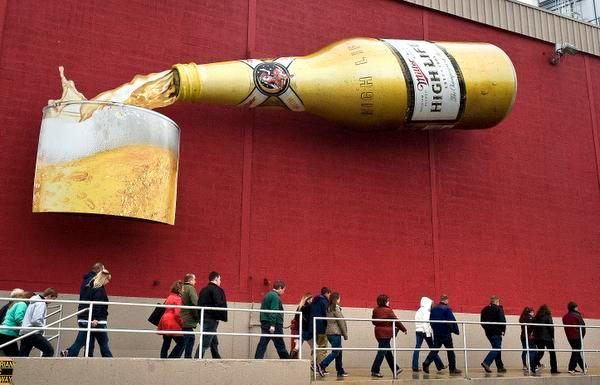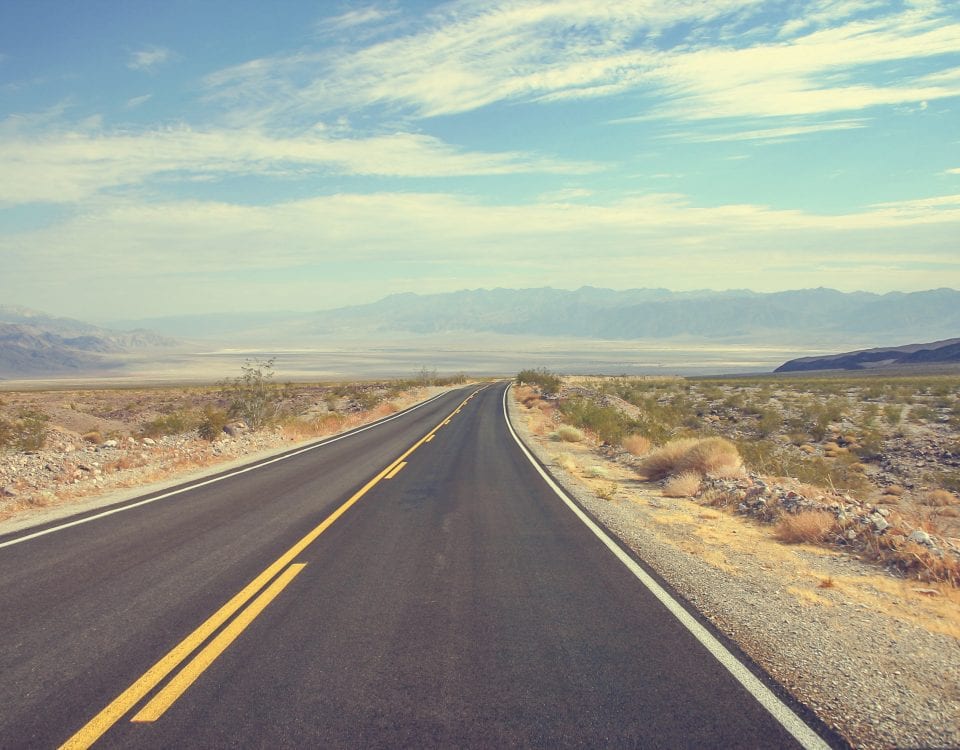
Day 47: The Road to Minneapolis
May 5, 2021
Day 45: In Iowa, A Tale of Two Fields
May 3, 2021Most recently updated on May 10, 2024
Originally posted on May 4, 2021
We’re winging it in Wisconsin today on Day 46 of our journey.
And it doesn’t take long to get there.
As soon as we leave Dubuque on Highway 61 eastbound we cross over the Mississippi River and enter Wisconsin.
The Badger State is also known as America’s Dairyland. It’s the 23rd largest state at 65,000 square miles and 20th in population with nearly 6 million residents.
It does have some hills with a mean elevation of 1,050 feet and a long shoreline with Lake Michigan, which we will examine later today.
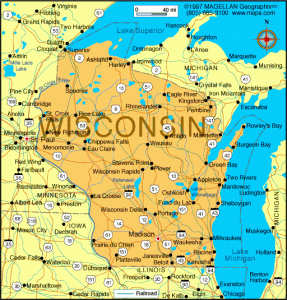
The first European explorers were French fur traders from the Great Lakes area. Great Britain took control the region from France after the French Indian War in 1763. The United States was awarded the territory after the Revolutionary War, but the new country didn’t take control of the area until after the War of 1812.
The region was named as the Wisconsin Territory in 1836 and then admitted as our 30th state in 1848.
Fur trading was the main industry in the 1600s and early 1700s. However, overhunting ended that era and lead mining took its place. Some early miners burrowed into dugouts for shelters and were called “badgers,” which is where the state nickname comes from.
Thousands of miners settled in Wisconsin in the 1820s and 1830s. At one time, the state’s mines supplied half of the country’s lead. The population in the territory jumped from 11,000 in 1840 to 300,000 in 1850. About one-third of the residents were foreign born, many of them immigrants from Germany and Scandinavia.
Eventually, lead mining faded and agriculture as well as lumber began to dominate. However, soil fertility problems hampered farmers, so many of them switched to the dairy industry. Manufacturing also boomed in the early 1900s, driven by immigrants.
Today, Wisconsin is the top cheese producing state, easily outdistancing second place California. It’s also first in cranberries and ginseng with about 98 percent of the U.S. cultivated crop grown here. Wisconsin is also second in milk as well as butter production, behind only California in both categories.
Lead, Trolls and Cornish Delights
Most of our route today is in an easterly direction, but after we cross into Wisconsin we take a detour by heading north on Highway 61 to a town known for its beer and a really long main drag.
It only takes 20 minutes to reach Potosi, a community of less than 650 people along the eastern banks of the Mississippi.
English, German and Irish settlers migrated to the region in the 1830s to work in the lead mines. The Potosi Badger Hut Sites contain the remnants of two structures used by these miners as well as 100 of their diggings.
Potosi was formed in 1839 when the leaders of three settlements decided to combine their communities. At one point, the town was the largest settlement in western Wisconsin.
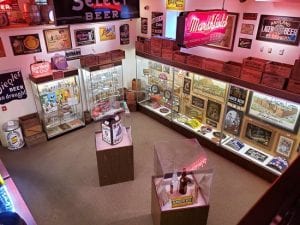
The National Brewery Museum in Potosi, Wisconsin. Photo by TripAdvisor.
There are two attractions that have drawn us here today.
The first you encounter as you enter the town off Highway 61. Main Street here cuts through downtown and then continues all the way to the Mississippi before hitting a stop sign. The locals say that three-mile stretch makes their road the longest uninterrupted Main Street in the world.
We take that roadway toward the Mississippi until we hit the Potosi Brewing Company. The facility also serves as the National Brewery Museum.
Inside the museum is the refurbished Potosi Brewing Company, which originally operated from 1852 to 1972 making “Good Old Potosi Beer.” The brewery opened again in 2008 after a $7 million restoration. More than a dozen beers are brewed here.
The museum section commemorates breweries of the past and houses antique equipment, beer signs, coasters and beer steins. It also features the various modes of transportation the industry used from riverboats to carriages to rail cars.
You can also look through a glass wall and view a cave dug into the limestone walls where ice hauled from the Mississippi refrigerated the beer. There also a flowing spring used in the brewing process, a beer garden and a carved bar where you can sample some of the home brews.
If fishing is more your thing, Potosi is known as the Catfish Capital of Wisconsin with an annual summer festival.
————————
We return on the long Main Street and leave Potosi, heading east on Highway 151.
In 40 minutes, we pull into Mineral Point, a town of 2,500 people with a history of lead, zinc and Cornish food.
Mineral Point sits in what’s known as the Driftless Region of Wisconsin where prehistoric glaciers did not flatten out the land. The town sits at an elevation of 1,037 feet.

The Red Rooster Cafe serves up Cornish food in MIneral Point, Wisconsin. Photo by TripAdvisor.
The town was founded in 1827 after large concentrations of lead ore in shallow deposits were discovered. Mineral Point quickly became a center of the lead processing industry. In the 1830s, Mineral Point had a larger population than Milwaukee or Chicago.
The lead ore industry flourished through the 1840s. Immigrants came from Cornwall, England, with expertise on how to dig out deeper ore. By 1845 half the residents here were Cornish. In 1847, the town’s furnaces were producing almost 44,000 pounds of lead a day.
The lead industry began to decline, especially after gold was discovered in California in 1848. However, the town rebounded with zinc mining and smelting after zinc ore was discovered underneath many of the lead ore deposits. The Mineral Point Zinc Company was founded in 1882 and by 1891 it was the largest zinc oxide works in the United States. The zinc industry continued strong until the 1920s.
The dairy industry became established in the late 1800s and Mineral Point beef was known in the Chicago trade markets.
A wave of restoration of historic buildings swept through the town in the 1960s and 1970s. One of the rehabilitated buildings is the Pendarvis, an historic site that contains cabins known as “badger holes” from the 1800s used by Cornish miners
The local restaurants are known for their Cornish food with the Red Rooster Café being among the better known.
—————————————
We continue northeast on Highway 151 before joining eastbound Highway 18 through the center of southern Wisconsin.
In a half-hour we reach Mount Horeb, a town of 7,600 people. This community also has a history with lead mining but is better known for its troll sculptures.
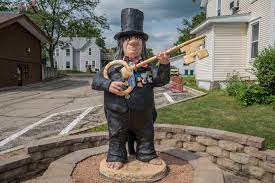
One of the many troll sculptures you will see in Mount Horeb, Wisconsin. Photo by GoodFreePhotos.
The Ho-Chunk tribe lived in the region for centuries before they were forced from their land under treaties signed from 1829 to 1837. Today, about 8,000 tribe members live on 8,800 acres in western Wisconsin
Lead ore was discovered in Blue Mounds area in 1828. The town was named after the mountain where Moses reportedly received the 10 Commandments. A sizeable influx of European immigrants initially came with a significant number of Norwegian immigrants arriving. The region eventually became known as “Little Norway.”
During the 1970s, the town decided to become the “Troll Capital of the World” and celebrate their Norwegian heritage by featuring wooden troll sculptures throughout town. These markers include “The Trollway” along Main Street. The first troll sculptures arrived in 1976 when the owners of The Open House gift shop imported them from Norway and placed them on the store’s front lawn. The locals became attached to them. Truckers and tourists also began to notice.
A Liberal Tradition
We truck on out of Mount Horeb and continue east on Highway 18 for yet another 30 minutes.
The road takes us straight to Madison, the state capital that lies on an isthmus between Lake Mendota and Lake Monona.
It’s the second most populous city in Wisconsin with 280,000 residents. It’s 71 percent white, 8 percent Asian, 8 percent Hispanic or Latino and 7 percent Black with a median age of 31.
Those demographics are partly due to the fact the city is the home of the University of Wisconsin-Madison, a college with a student population of 50,000 and a long history of liberal politics.
Native tribes inhabited the region more than 2,000 years ago. The most recent residents were the Ho-Chunk.
The town was founded in 1829 when federal judge James Dwyane Doty purchased most of the land in the area. Doty persuaded state legislators to make Madison the state capital when it was still a wooded area. He named the city after President James Madison and named streets after the other 39 signers of the U.S. Constitution.

Teddywedgers restaurant caters to University of Wisconsin students. Photo by the city of Madison.
The first white settlers arrived in 1837. The university was founded in 1848. The Milwaukee and Mississippi Railroad arrived in 1854. An initial wave of migrants came from the East Coast. They were followed by European immigrants.
During the Civil War, Madison was a center for the Union Army in Wisconsin. The Union House Tavern at the Union Corners intersection of Milwaukee, East Washington, Winnebago and North streets was where soldiers had a final drink before heading out to fight the Confederates. The tavern remained open for another 140 years before it closed in 2007.
Today, Madison is known for its lakes, restaurants and network of parks and bike trails
The two biggest employers here are the state government and the university, but since the 1990s the town has been trying to boost its economy with bio-tech, health and advertising. The metropolitan area is headquarters for Epic Systems, American Family Insurance, American Girl, Sub-Zero and Lands’ End.
The city still has a large agricultural industry, in particular food processing. Oscar Mayer used to have its headquarters here. At one point, it employed 4,000 people. It left in 2015 after 97 years when the company was purchased by Kraft. Oscar Mayer’s headquarters is now in Chicago. In March 2023, Madison leaders approved a plan to build 500 apartments for seniors and low-income families on the now-vacant low. As of February 2024, some commercial and residential facilities had opened, but much of the project remains to be built.
Since the 1960s, Madison has been a center of political liberalism. During the Vietnam War, protests were focused in the “Miffland” area near Mifflin and Bassett streets. The Mifflin Street Block Party grew out of these protests and was held every spring. However, in January 2023, city officials said they would no longer sanction the event due to safety concerns. Nonetheless, 10,000 people showed up in April 2023 for the party. Police said they made dozens of arrests and city officials renewed their call to shut down the gathering in the future.
Madison also has a large LGBTQ population. Its student culture has given the city the nicknames “Madtown” and the “Berkeley of the Midwest”
“The Onion” newspaper, now headquartered in Chicago, began in Madison in 1988.
State Street has a host of restaurants and bars that catering to students, including Teddywedgers that serves Cornish pastries. There is a Great Taste of the Midwest craft beer festival held in August.
Officials in Madison are buoyed by the prospect of passenger rail service finally coming to town. Rail lines through Milwaukee and Madison are considered likely as part of the $66 billion in funding for Amtrak train service in President Joe Biden’s infrastructure bill. In January 2024, city officials pinpointed eight sites to study as possible locations for a new Amtrak station.
Promises, Publishing and Garbage Disposals
We turn south out of Madison for a two-hour drive to a town where many people feel that they’ve been duped by a Taiwan-based company.
We grab southbound Interstate 90 for a little less than an hour. Along the way, we drive by Lake Koshkonong. This 10,595-acre body of water was formed when Indianford Dam was built in 1846. Other dams were also built in 1917 and 1931. A Wisconsin Power and Light Company plant generated hydroelectric power at the lake until it became economically infeasible in 1961.

Lake Koshkonong in Wisconsin is shallow and suffers from pollution problems. Photo by the Wisconsin Department of Natural Resources.
One of Lake Koshkonong’s problems is it has a maximum depth of only 7 feet, so it actually doesn’t contain a lot of water. Two waste treatment plants discharge materials into Rock River, which feeds into the shallow lake. That has turned Koshkonong into one the more polluted lakes in the country.
The lake also has poor visibility and a history of flooding nearby neighborhoods.
Not too long after we pass the lake, we exit I-90 and head east on a series of two-lane highways. They eventually take us to Mount Pleasant, a town of 27,000 residents that is still waiting to hear what’s going to be done with the land once set aside for a large factory.
In October 2017, Foxconn announced plans for a $10 billion flat TV factory in Mount Pleasant. President Donald Trump even visited in June 2018 for a groundbreaking. Foxconn was promised $4 billion in state and local government incentives.
In January 2019, the Taiwanese company announced it wouldn’t build the TV factory but might put together something smaller, perhaps a technology hub with a molding station. Foxconn said it still planned to employ 13,000 workers.
After, things became murkier.
Three structures were built on the 3,000-acre property. A 120,000-square-foot storage facility was finished in 2018. A 1 million square foot manufacturing complex was completed in 2020, but that has been mostly used for storage. A globe-shaped structure that was supposed to house a network operations center is nearing completion, although it’s uncertain what it will be used for.
Foxconn has announced numerous plans over the past few years about the site, including the possibility that electric vehicles will be made there.
The uncertain status of the project led Hintz Real Estate Development Company to file a lawsuit in February 2021 against Foxconn for breach of contract.
In April 2021, the governor’s office announced a new agreement has been reached with Foxconn. Officials said the company will receive fewer tax credits but did not offer any other specifics.
In February 2022, it was announced that Denmark-based Oterra would operate a natural food coloring operation out of the Foxconn building.
In May 2023, Microsoft purchased 315 acres of the Foxconn property, where they plan to spend $1 billion on a new facility. In November 2023, town officials approved the sale of the property, paving the way for a project that will include at least four data centers employing more than 1,000 people. In May 2024, President Joe Biden praised Microsoft’s plans to build the $3 billion center that will eventually employ 2,000 people.
————————————-
Racine is just 15 minutes east of Mount Pleasant.
The town of 75,000 people rests on the western shores of Lake Michigan at the mouth of the Root River.
It’s reportedly home to the largest Danish community in North America outside of Greenland. Racine is known for its Danish pastries. An O&H Danish Bakery was even visited by President Barack Obama in 2010 on his way to a town hall gathering.
The Potawatomi were among the Native tribes that lived here, hunting and eating the wild rice, corn, potatoes, squash and fruit that grew in the area. They were forced out in 1833.
The first European visitors arrived in 1679. A trading post was established in 1791 with the first European settlers arriving in 1835. The town was named after the French word for “root.”
A saw mill was built in the settlement’s early years. It was incorporated as a city in 1848. The first railroad arrived in 1853.

The O&H Danish Bakery in Racine, Wisconsin. Photo by the O&H Danish Bakery.
Racine developed into a factory town that manufactured shoes, clothing, soap, candles, boats and bricks. The harbor also served the agricultural community that shipped wheat, flour, corn, oats, cheese, butter and beef.
European immigrants arrived in the 1840s followed by people from Mexico as well as Black transplants from the Deep South. Racine was strongly anti-slavery and was involved in the rescue of captured runaway slave Joshua Glover in 1854.
A number of successful companies got their start in Racine.
The J. I. Case Company was established in 1844. The company grew after it developed a threshing machine for grain. Case is now a subsidiary of Tenneco. It’s currently the second largest manufacturer of farm equipment.
Mitchell Wagon Works started making wagons here in 1854. The company manufactured bicycles and motorcycles as Wisconsin Wheel Works starting in 1896. It switched to cars in 1903, eventually under the name Mitchell-Lewis Motor Company. Its two factories covered 25 acres and employed 3,000 people. They closed in 1923.
The Horlick Company was formed after William Horlick invented malted milk as a nutrition supplement in 1873. The operation moved to Racine in 1875 and helped establish milk quality standards. The company’s malted milk was shipped all over the globe, including Antarctica, where the Horlick Mountains are located. The Horlick plant shut down in 1975. In 2021, construction began on the site on a $100 million Horlick District development that will eventually include residential, commercial, retail, education, hospitality and recreation spaces. In May 2022, the first apartment residents moved in.
In 1927, John W. Hammes invented the garbage disposal here in in his basement workshop. He formed the company still known as InSinkErator. The company opened a new $34 million headquarters in Mount Pleasant in 2018. It is still world’s largest manufacturer of garbage disposals.
Finally, Western Publishing began publishing Little Golden Books in Racine in 1942. Western stopped its printing operations in 2001. Penguin Random House now publishes Little Golden Books.
To boost tourism, the Reef Point Marina was built in the 1980s as way to attract visitors to town.
The city does have an inclusive prom tradition, too. The Rotary Clubs of Racine holds an all-city prom for all nine high schools in the city. The event was cancelled in 2020 and in 2021 due to the COVID-19 pandemic. However, the Rotary Club sponsored an outdoor post-prom celebration in August 2020 and another one that was held on May 15, 2021. The 2022 prom was held in its traditional format as was the 2023 prom.
An interesting business opened in town in December 2021. It’s called Inmoxicated, a bar that will serve only non-alcoholic drinks. The establishment will provide a traditional tavern-like experience with pool tables and dartboards and a variety of drinks. It’s just none of them contain liquor.
The Road to Milwaukee
We head straight north out of Racine and head up Highway 32, hugging the shoreline.
This is our first real glimpse of Lake Michigan, the only one of the Great Lakes located entirely in the United States.
Michigan is the second largest of Great Lakes by volume and third by surface area. It’s 321 miles long with a maximum width of 118 miles. The average depth is 279 feet.
Four states – Michigan, Illinois, Wisconsin and Indiana — straddle its 1,600 miles of shoreline.
Its ports include Chicago, Milwaukee, Green Bay and Gary, Indiana. A total of 12 million people live along the lake. Much of shoreline is dependent on fishing and other recreation with industry dominating in the Chicago area and along Indiana border.

Lake Michigan is the only one of the Great Lakes that is entirely within the United States. Photo from Pinterest.
The lake has a considerable number of beaches and is sometimes referred to as the “Third Coast” of the United States, although people along the Gulf Coast in the southern United States might argue. The Lake Michigan shoreline includes an abundance of sand dunes, including the Indiana Dunes National Park. There are 102 lighthouses along its shores
Lake Michigan is connected to Lake Huron via the Straits of Mackinac. It’s also part of Great Lakes-St. Lawrence Seaway
The word “Michigan” comes from the Native American word “Michi Gami,” which means “large lake.” The Hopewell Indians lived along the lake. The French explorer Jean Nicolet is believed to be the first European to see the lake when he arrived in 1634.
Lake Michigan has a history of pollution problems, mainly due to shoreline industrial uses. Lawsuits that were filed in the 1970s as well as the Clean Water Act of 1972 helped reverse some of the ecological deterioration.
The main concern has now shifted to climate change.
A 2018 report noted that the surface temperature of the lake has risen 3 degrees since 1980. This warming threatens to destroy native habitat. A 2019 story on NPR detailed concerns over rising water levels as well as coastal erosion, especially among sand dunes. A 2023 report stated that climate change is causing water levels to rise on the lake, submerging some of its beaches.
A March 2021 report from the National Oceanic and Atmospheric Administration (NOAA) rang alarm bells, stating that climate change is already causing “significant impacts” on the entire Great Lakes region. They warn of warming temperatures at deep water depths that could change the lakes ecosystem, among other concerns.
The NOAA says that these changes can have consequences on the people who live near the lakes as well as the industries that use them.
————————————–
Milwaukee is one of those cities that would be affected.
This city of 558,000 people nestles right along the Lake Michigan coastline.
Milwaukee is the most populous city by far in Wisconsin. Its ethnic mix is listed as 38 percent Black, 33 percent white and 20 percent Hispanic or Latino. Its median annual household income is $49,000. The poverty rate rests at 24 percent.
Milwaukee is known for its breweries, but it also has a historic connection to motorcycles, bobbleheads and a popular nostalgia television show of the 1970s.
Native tribes lived along Milwaukee’s waterways for 13,000 years. The tribe members participated in the French and Indian War as well as the American Revolutionary War. They also fought against the United States in the War of 1812 in response to colonial expansionism. The tribes were subsequently forced to leave the region in 1833.
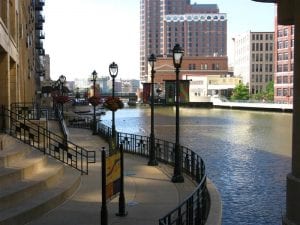
The Milwaukee Riverwalk is a popular place to stroll in the city. Photo from Pinterest.
The first European visitors were missionaries and fur traders who passed through in late 1600s. The community was founded in 1818 by French explorer Solomon Juneau. There were three separate settlements at first that competed to the extent they wouldn’t align their bridges with other city’s streets. The residents finally incorporated as one city in 1846.
The founders saw Milwaukee as a port city. They utilized the railroads to get wheat from Wisconsin farms to the docks. In the 1860s, Milwaukee shipped more wheat than any other place in the world. Chicago eventually overtook Milwaukee as the regional commerce center.
A large number of German immigrants started coming in after the failure of an 1848 revolution in Germany. Polish, Irish and Italian immigrants arrived in the ensuing decades. By 1900, 75 percent of the population were immigrants and their children. African-Americans came from South during World War Two to work in factories.
The German immigrants established breweries as early as the 1840s around the port facilities, using barley and hops from the farmlands. There were 35 breweries established between 1840 and 1860. At one point, Milwaukee was home to four of the largest breweries (Schlitz, Blatz, Pabst and Miller) and was one of the top beer producing cities in the world.
These facilities helped produce side industries such as glass blowers, bottlers and ice harvesters.
In addition, tanneries opened with the Pfister and Vogel Leather Company plant being one of the world’s largest by 1910. It closed in 2000.
The city also started to specialize in cream colored bricks from the region’s clay. At one point George Burnham’s Cream City brickyard employed 200 people and produced 15 million bricks per year. By the 1920s, however, the industry faded after the sources of clay became depleted.
Since 1980, manufacturing has become less important. The past two decades, the city has shifted to a services economy. It is also home to the headquarters of Northwestern Mutual and Harley-Davidson.

The National Bobblehead Museum in Milwaukee, Wisconsin. Photo by The Business Journals.
There have also been redevelopment projects such as Miller Park and the Milwaukee Riverwalk, a 3-mile trail system along both sides of the Milwaukee River with restaurants, pubs and other features. In 2021, construction began on the $188 million Couture apartment tower, nearly 9 years after it was first proposed. The first residents are expected to arrive in April 2024. The Couture is the tallest residential building in Wisconsin and has altered Milwaukee’s skyline.
Despite all the new projects, the beer industry is still important here.
Milwaukee remains well known for its breweries, although Miller is the only major brewery left. It still employs 1,300 people. In 2008, Coors partnered with Miller to form MillerCoors for U.S. operations. There’s also been a recent resurgence of microbreweries in town.
Milwaukee is also well known for its German restaurants and its sausages, including the popular Usinger’s factory, deli and shop. There’s also a Purple Door Ice Cream parlor with beer-flavored ice cream that is 1 to 3 percent alcohol.
The city’s ethnicity variety has led to racial unrest and segregation. A 2016 article by Diversity Inc. discussed how the collapse of the manufacturing industry has exacerbated the city’s long history of racial tension. In 2019, Milwaukee was ranked by 24/7 Wall St., a Delaware financial services firm, as the worst city in the country for Blacks due to disparity in employment and income. Racine, the city’s neighbor to the south, was listed as second.
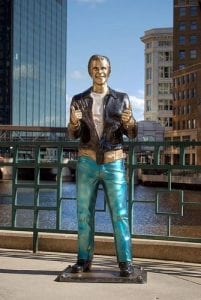
The Bronz Fonz statue in Milwaukee, Wisconsin. Photo from Pinterest.
Accusations of racism were leveled after a February 2020 shooting at the MillerCoors plant in which an employee killed himself after gunning down five co-workers. After the shooting, former employees said there was a culture of racism at the facility. In 2015, a noose was found hanging on a locker. The former employees speculated that the gunman, who was African American, may have been spurred by the racial tensions. Investigators still have not determined the motive for the massacre.
Milwaukee is also trying to deal with an increase in violence. In September 2021, city and police leaders said they were working on solutions to the rash of gun violence that had plagued their community this year. The cries to end the “tidal wave” of gun violence were repeated in February 2022 after five people were wounded by gunfire outside a high school. There were a record 214 homicides in Milwaukee in 2022, even though serious crime overall declined by 15 percent. That number dipped to 169 homicides in 2023.
Despite these problems, the city does have its tourist attractions and community events.
It’s known as “The City of Festivals.” One of those events is the 11-day Summerfest, which has attracted more than 800,000 people in the past and is considered the largest music festival in the world.
The city is also home to the Harley-Davidson Museum. The 130,000-square-foot museum is in three buildings on 20 acres. The facility, which opened in 2008, celebrates the long history of Harley-Davidson motorcycles. In a typical year, it has more than 300,000 visitors.
There’s also the National Bobblehead Hall of Fame and Museum, which opened in early 2019. The facility has the largest collection of bobbleheads in the world. They range from baseball players to television stars to cartoon characters. The museum also has dozens of exhibits detailing the history of bobbleheads as well as the manufacturing of the collectibles.
Finally, there is a Bronze Fonz statue along the city’s North Riverwalk. The statue, installed in 2008, pays homage to Henry Winkler’s character Arthur “Fonz” Fonzarelli on the 1970s television comedy “Happy Days.” The statue is complete with leather jacket and the Fonz giving it “two thumbs up.”
The “Happy Days” show, which also starred Ron Howard, was set in Milwaukee in the 1950s and 1960s as was its spinoff series, “Laverne and Shirley.” The two main characters in that show worked in a brewery.
Seems like a nostalgic place to end Day 46.
Tomorrow, we cut across Wisconsin’s dairy territory before reaching the upper Midwest’s premier city, a place full of art and history that has been dealing with the issue of racism and police reform for the past few years.

